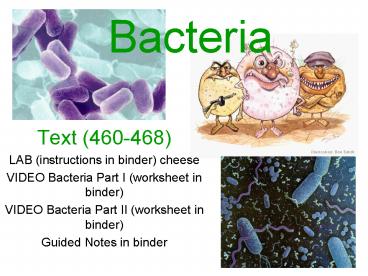Bacteria - PowerPoint PPT Presentation
1 / 38
Title: Bacteria
1
Bacteria
- Text (460-468)
- LAB (instructions in binder) cheese
- VIDEO Bacteria Part I (worksheet in binder)
- VIDEO Bacteria Part II (worksheet in binder)
- Guided Notes in binder
2
Vocabulary
- endospore,
- antibiotic,
- anaerobic,
- toxin,
- capsule,
- pili
3
The study of bacteria Bacteriology
- KINGDOM formerly Monera
- Now 2 Domains Archeabacteria, Eubacteria (more
about these later in the year) - Only Prokaryotic cells
- Only Prokaryotic Domains
4
Characteristics of
- Prokaryotic Cells
- Originated 3.5 bybp
- No nucleus
- Loop of DNA
- Few organelles
- No compartments
- Very small 1-2µm
- (microns 1/1000 of a millimeter)
- 1/1,000,000 of a meter
- Eukaryotic Cells
- Evolved 1.5 bybp
- Nucleus- holds the DNA
- Many organelles
- Mitochondria
- Chloroplast
- Golgi body
- Endoplasmic reticulum
- cytoskeleton
5
ANATOMYDraw and label cell with the following
structures
- pili
- flagella
- cell membrane
cell wall capsule plasmid, cytoplasm
6
(No Transcript)
7
II Common Bacterial SHAPES
8
Coccus -sphere shaped
Strepto- linear
Staphylo- sheet
9
Bacillus- rod shaped
BACILLUS ANTRACIS
PSEUDOMONAS AERUGINOSA
10
Spirillum- spiral shaped
Spirillum sp.
11
Do not write this!
- There are many ways to classify bacteria
- The choice depends on what you are interested in
studying - Anatomy?
- Physiology?
- Harm to humans?
- Food source?
12
Archaebacteria-
- Methanogens methane producing, found in the gut
of animals and swamps - Extremehalophiles salt loving, Dead Sea
- Thermoacidophiles hot springs and geysers with
acidic water
13
Eubacteria
- Recycle nutrients into the soil(break down large
molecules proteins, lipids, carbohydrates, into
simple molecules that can be absorbed by plants) - Cyanobacteria also called blue green algae,
photosynthetic bacteria
14
III. CLASSIFICATION by how they obtain energy
- Photosynthetic- energy from sunlight
- Green sulfur bacteria, cyanobacteria, purple
sulfur bacteria - Chemoautotrophic- energy from electrons in
inorganic molecules - Nitrobacter, nitrosomonas
- Heterotrophic- organic materials from other
organisms - Streptomyces, rhizobium
WRITE THIS ON THE BACK OF YOUR BACTERIA DRAWING
15
IV METABOLISM
- Obligate anaerobes- must live where there is no
oxygen - Obligate aerobes- must live where there is
oxygen - Facultative aerobe or facultative anaerobes- can
live in either but prefers one.
16
V DISEASES
- Clostridium tetani tetanus, produces a toxin (
caused by deep puncture)
17
Clostridium tetani
18
- C. botulinum botulism , food poisoning
(caused by poor canning) Toxin is odorless and
tasteless.
19
Clostridium botulinum
20
- Borrelia burgdorferi- Lyme disease (carried by
deer ticks) Named for Lyme County Conn.?
21
Borrelia burgdorferi
Lyme Disease
22
- Salmonella sp. Food poisoning (associated
with eggs and poultry) - Many different species
23
Salmonella sp.
24
- Yersinia pestis- bubonic plague Black Death
changed the course of history - Thought to be carried by rats but actually
carried by fleas
25
Yersinia pestis Bubonic Plague (Black Death)
26
- Mycobacterium tuberculosum- tuberculosis
(infects the lungs) Now there are some drug
resistant strains.
27
Mycobacterium tuberculosum
28
USES
- Lactobacillus sp. Yogurt,sauerkraut pickles,
vinegar - Actinomycetes- antibiotics streptomycin
- Chemicals that kill other prokaryotic cells
29
- E. coli- in digestive tracts
of humans, used in the
manufacture of linen from
flax (plant) - Excess, wrong location, or wrong species can be
dangerous to humans.
30
- Rhizobium sp. Associated with the
roots of legumes (pod plants) Helps "fix"
atmospheric nitrogen into the plants
to help make proteins. Enriches
soil, plants are high in protein. - Tanning leather, silage
(fermented hay increases
protein content) silo
31
VII ENVIRONMENTAL FACTORS THAT INFLUENCE GROWTH
- Temperature up or down
- light
- Oxygen present
- amount of wastes
- Food availability
- presence of chemicals (salt)
- Amount of water
32
COMPETITION (secrete toxins)
- Endotoxins- part of the cell wall is poisonous
- Exotoxin- chemicals poison is released
33
VIII LEVELS OF CLEANING
- Refrigeration SLOWS GROWTH
- Antiseptic PREVENTS GROWTH
- Disinfectant DEATH OF PATHOGENS IN A MEDIUM
- Sterile REMOVES ALL FORMS OF LIFE
- Pasteurization DESTRUCTION BY HEAT OF DISEASE
CAUSING ORGANISMS FROM BEVERAGES
34
IX METHODS OF CLEANING
- MECHANICAL
- CHEMICAL
- RADIATION
- TEMPERATURE AND PRESSURE
- (AUTOCLAVE)
- ENDOSPORE protoplasm of bacteria cell becomes
encased in a spore coat. Protects from
environment -250 C to over 100 C
35
X FOOD SPOILAGE AND PRESERVATION
- CANNING
- SALT CURING
- DEHYDRATION
- QUICK FREEZING
- RADIATION
- VACCUM PACKAGING
- CHEMICAL PRESERVATION
36
Test Topics FOR Tuesday
- Video Bacteria I and II worksheets
- Lab results (cheese, bacteria cultures)
- Notes on Anatomy, classification, diseases, uses,
preservation of food and cleaning - Text (460-468) Vocabulary 16-21
- Bacteria word search
37
NOTEBOOK CONTENTSDue Tuesday (next test day)
- Daily Work
- Text Ques pg. 9 22
- Analyzing sci words
- Branches of Biology
- Chap 12.1
- Chap 12.2
- IV and DV worksheet
- Biome Measuring
- Bacteria Video Part I
- Bacteria Video Part II
- Bacteria Word Search
- Systems
- Cover Sheet
- Assignment Sheet
- Grade Sheet
- Vocabulary 1-21
- Notes
- Labs
- Microscopy
- Biome Research
- Bioethics
- Cheese Making
- Bacteria Cultures
38
- Difficult - Answers
- Protoplasm of bacterial cell becomes encased in a
spore coatvery hard to killyou have to
autoclave to kill - Look at Slide 5 of this presentation
- Random mutations that occur
- PenicillinAlexander Flemingpenicillin comes
from a mold or fungus - It is their specific waste product
- There are different strains of E.coli and they
all are different. In some strains, they are
okay for the bodyin some strainsthey can harm
the body. - It destroys microbes by heatin things like milk,
juices, wines, and malt beverages. Louis Pasteur































